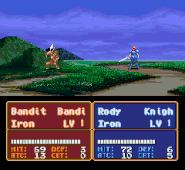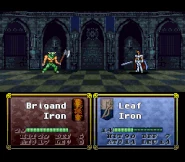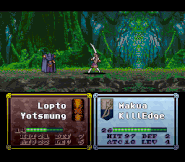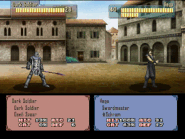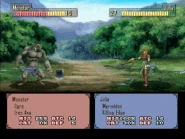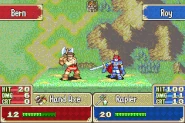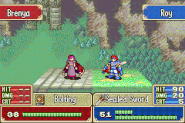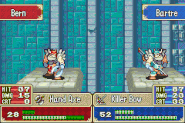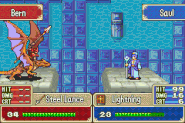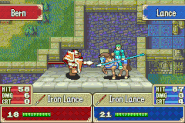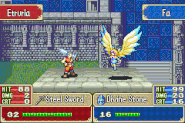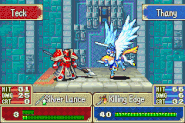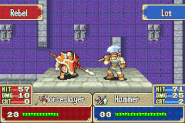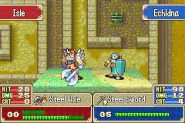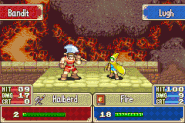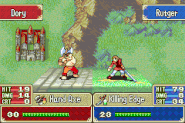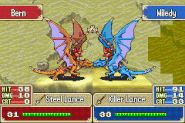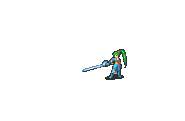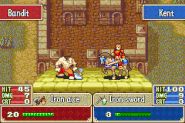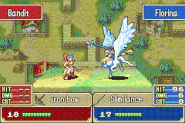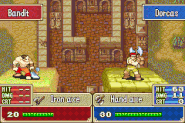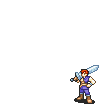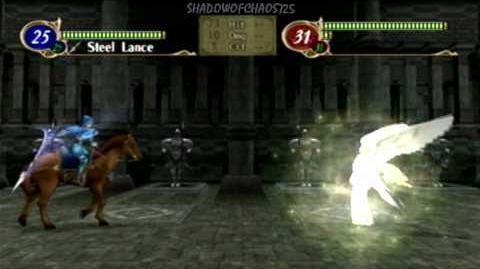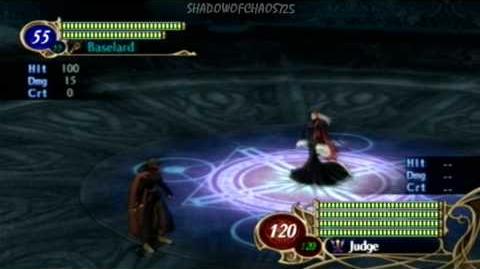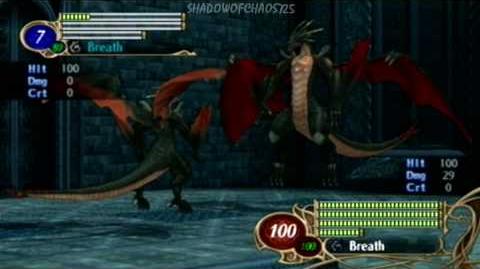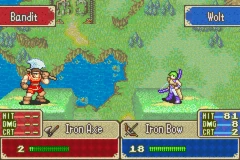
Wolt performing a critical hit on an enemy bandit in battle in Fire Emblem: The Binding Blade.
A Critical Hit (必殺 Hissatsu lit. Certain Kill) occurs when a unit performs a stronger attack that deal triple damage to their target.
Description
A unit's critical hit rate at any given time is most directly influenced by the equipped weapon's "crt" stat. Most weapons raise the chance of scoring a critical hit by only a small amount; however, certain weapons and spells (e.g.: Killer Lance, Killing Edge, Killer Axe, and Luna) have a higher chance of landing a critical hit than most weapons. Even then, the critical hit rate is usually around 35 percent, depending on the class and level of the unit wielding the weapon.
However, there is a possibility that the Critical hit rate can be up to 80% without the use of hacks, depending on the weapon itself, the user and their level, and the Luck between two units. For example, if you use a Swordmaster, with an Iron Sword, the average critical activation rate can go from 10-45. If you give the Swordmaster a Killing Edge, the critical hit rate drastically rises to 45-66. Giving the Swordmaster a Shamshir would increase the rate to 71 or even more.
In most games in the series, when a critical hit activates, the critical-inducing unit performs a flashy set of movements unique to its class. For the most part, melee weapon units spin their weapons rapidly when performing a critical hit; some sword-wielding classes, such as the Swordmaster or Myrmidon, move fast enough to make it appear that they are in more than one place at once and that they disappear momentarily. Magic-using units have a tendency to visibly summon or charge more energy in some ways, such as the Druid tendency to be ringed by their power. In the Tellius series there are two animations for a critical hit: one for a killing blow and the other if it simply causes damage. Also, the airborne units have a Critical Hit animation for battles against ground units and another one against airborne units. In Awakening, when a unit activates a critical, a small cut-in appears of the character (Except for Einherjar characters) along with a critical quote. They will have a specialized attack only for criticals and their weapons will have a pink streak when they attack. Criticals can activate for attacking skills such as Luna, but the attacking animation for that attack skill will prioritize over the critical animation unless the user has activated Ignis. Fates continues the this trend, though the streaks displayed are now light blue. Several classes have different critical animations depending if the character is wielding either a Hoshidan or Nohrian weapon.
In Fire Emblem: Genealogy of the Holy War, Fire Emblem: Thracia 776 and TearRing Saga: Utna Heroes Saga, critical hits multiply base attack by two instead of multiplying final damage by three, usually making them considerably more dangerous than normal in most circumstances.
In Fire Emblem Fates, certain weapons will deal four times the amount of damage instead of three; the Killing Edge and Mjölnir weapons are examples of such.
Calculations
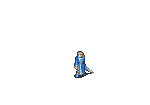
A Swordmaster performs a critical hit.
Factors
- Class Critical Bonus: Some promoted classes, notably the Swordmaster and Berserker, have a "class critical bonus", which represents a base critical hit rate a member of the class will almost always have in battle. In Fire Emblem: Radiant Dawn, there were five levels of Class Critical Bonuses (Critical +5, Critical +10, Critical +15, Critical +20, Critical +25), represented as skills permanently attached to the Sniper, Marksman, Reaver, Halberdier, Sentinel, Assassin, Myrmidon, Swordmaster and Trueblade classes.
- Skills: Some skills increase critical hit rate under certain circumstances. For example, the Wrath skill boosts the critical hit rate when the user's HP is at 1/3 or less while Death Blow increases critical hit rate when the user initiates a battle.
- Pursuit Critical Coefficient in Fire Emblem: Thracia 776 a limit is placed on critical rate during the first Double Attack hit and then multiplies it during the second hit.
- Dual Support in Fire Emblem Awakening and Fire Emblem Fates boosts the critical activation rate depending on the support rank level that the attacking unit has with their Pair Up partner and any adjacent allies. Critical activation is boosted by 10 at level 4, 15 at level 8, and 20 at level 12.
Critical hit rate calculation
Unit's skill/2 + 5% (If S-rank in The Blazing Blade and The Sacred Stones) + the weapon critical chance + the support bonus (if any) + the class critical bonus (if any) + character's skills (if any) - the enemy's Luck.
- To calculate a Silencer percent chance of an Assassin, you must halve his Critical Hit percentage (except in Radiant Dawn, where it is half the skill stat, and in Awakening, where it is one fourth of it).
Hence, it is possible in Fire Emblem: The Blazing Blade for Swordmasters to gain a Critical Hit rate of 100% or more; when it exceeds 100 percent, only the last two digits will be shown. In Fire Emblem: The Sacred Stones the unique Super Trainee classes also can get 100% Critical.
However, the unit must also be able to hit the opponent first. That is, the hit percentage is taken into consideration before the critical percentage. So if a unit has a low chance to hit, but a very high chance to use a critical, (like from the use of the Gamble skill) the unit may miss altogether.
- While it may be true that the unit must be able to hit the target to get a critical hit in most Fire Emblem games, it is notable that in at least the United States version of Fire Emblem: The Blazing Blade, it is possible to get a critical hit when your hit rate is 0%, making enemy Swordmasters, Snipers and especially Berserkers particularly deadly against units whose survival rely on evasion, as the critical chance completely ignores the target's speed.
Critical hits can be completely negated by a unit carrying an Iron Rune (or Hoplon Guard) or with the skill Fortune.
Non-Canon Appearances
Super Smash Bros. Brawl
Critical Hit (必殺の一撃 Hissatsu no Ichigeki lit. Sure-Killing Blow) is the name of Marth's Final Smash in Brawl. Critical Hit is an extremely fast and powerful Final Smash. After raising his sword, Marth quickly rushes forward, instantly blowing away the first enemy that he connects with. He can knockout multiple enemies if they are in close proximity with the first enemy he connects with. A Health Meter appears, graphically similar to the ones in Shadow Dragon and the Blade of Light, which rapidly depletes to 0, but is purely for aesthetics. It is arguably one of the most powerful Final Smashes in the game, not just for the 60% damage if it connects, but for the knockback effect, able to KO Bowser, the heaviest character in the game, even when he is at 0% from the opposite edge of a medium sized stage. It can also be launched in the air and he will still propel him straight forward. However on smaller stages, Marth can actually launch himself offscreen using this move and suicide KO himself. Another down side is the long start up time which gives opponents time to telegraph the move and avoid accordingly. If the A button is pressed during the dash, Marth can immediately execute the attack, preventing him from dashing off the stage if possible.
Super Smash Bros. for Nintendo 3DS and Wii U
Critical Hit (必殺の一撃 Hissatsu no Ichigeki lit. Sure-Killing Blow) is the name of Marth, Lucina, and Roy's Final Smash in Super Smash Bros. for 3DS and Wii U. It has the same properties like it did in Brawl for Marth and Lucina. The Health Meter has been changed to appear similar to the one used in Awakening.
Roy's version visually is the same as his critical hit when he's equipped with the Binding Blade in The Binding Blade, making it a stationary Final Smash. As a result, Roy's version does not have the risk of self-destructing, however, his version has less knockback. During the wind up of the move, enemies within two character lengths in front of Roy will receive up to 5% damage. Characters within two character lengths behind him can receive up to 10% in damage and will be forced in front of him. Roy will then slam his blade into the ground, creating a large explosion, dealing 35% damage. It requires at least 50% damage on Bowser prior to the start of the move in order to KO him from the opposite side of Final Destination. Health Bars will also appear over characters who are hit by the Final Smash.
Super Smash Bros. Ultimate
Critical Hit (必殺の一撃 Hissatsu no Ichigeki lit. Sure-Killing Blow) is the name of Marth, Lucina, and Roy's Final Smash in Super Smash Bros. Ultimate. Marth and Lucina's version of the technique is the same rushing variation while Roy retains his unique stationary version.

